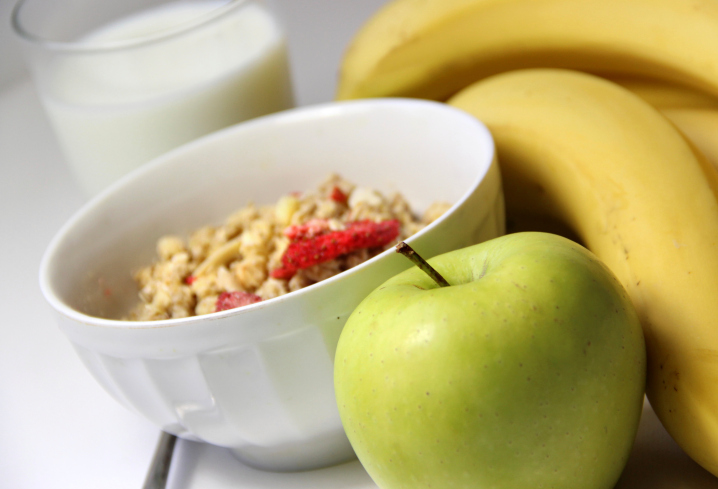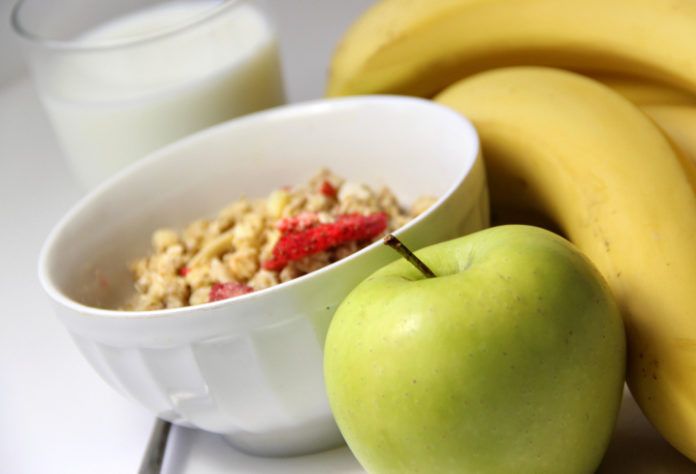So much nutrition news seems to focus on what not to eat-avoid this, consume less of that. Its especially welcome, then, to read about research recommending that you eat more of something-namely, potassium. Best of all, this essential mineral comes in a variety of tasty forms, from bananas (the food most popularly associated with dietary potassium) to apricots, sweet potatoes to fish, citrus fruits to nuts. Mealtime favorites ranging from beans to tomato paste to potatoes are high in potassium, as are dairy products such as yogurt. As bananas renowned potassium power suggests, fruits and vegetables are especially good ways to eat more potassium, with the added bonus of other important nutrients and fewer calories than other sources.

And yet most Americans dont get enough potassium in their diets. The Adequate Intake (AI) for adults is 4.7 grams of potassium-a little more than the amount in 10 bananas. On average, Americans fall a full gram short of that goal, and levels of potassium in the US diet have actually dropped about 10% since 1945.
Alice H. Lichtenstein, DSc, director of Tufts Cardiovascular Nutrition Laboratory, says, It is fortunate that good sources of potassium include all the types of foods that should be encouraged. Hence, even small steps towards improving the overall quality of the diet will likely result in an increase in potassium intake.
The 2010 Dietary Guidelines for Americans made boosting dietary potassium a priority, adding, Americans should select a variety of food sources of potassium to meet recommended intakes rather than relying on supplements.
Its possible to get too much of a good thing, of course, but excess potassium (hyperkalemia) is primarily a concern for people with reduced kidney function, such as dialysis patients. Certain medicines also affect the bodys ability to get rid of potassium, such as angiotensin converting enzyme (ACE) inhibitors, commonly prescribed for hypertension. Patients with such conditions should consult their healthcare professionals before making dietary changes.
Other health conditions and medications can contribute to potassium deficiency (hypokalemia). Diarrhea and vomiting can deplete the bodys potassium levels, and several rare kidney and adrenal-gland disorders can cause deficiency. Diuretics for the treatment of high blood pressure or heart failure, laxatives and steroids can cause a loss of potassium.
But for most people the problem isnt potassium levels so low as to be classified as deficiency-its simply falling short in day-to-day potassium intake. Even moderately low potassium levels, however, can contribute to salt sensitivity and high blood pressure. And, most important, if youre not getting enough potassium in your diet, youre missing out on this minerals positive health benefits, from combating cardiovascular disease to keeping you strong as you age.
Potassium vs. Sodium
If you remember your high-school chemistry, potassium (chemical symbol K, from the Latin kalium) sits just below sodium (Na) on the periodic table of elements. That means potassium and sodium are chemically similar, and its why potassium can take the place of sodium in salt substitutes. In the body, both are electrolytes.
- Potassium is essential for the proper function of your cells, tissues and organs. Among other functions, potassium:
- Is essential for the normal electrical functioning of the heart and nerves.
- Helps in the synthesis of proteins.
- Contributes to the building of muscle.
- Assists in the regulation of the bodys acid-base (alkaline) balance.
Much as sodium can contribute to high blood pressure, potassium-sodiums beneficial chemical cousin, if you will-can help bring down blood pressure. In developing the latest Dietary Guidelines, experts including Tufts Miriam E. Nelson, PhD, evaluated 10 studies of potassium and blood pressure compiled in the USDAs Nutrition Evidence Library. Dietary potassium intake was associated with a significant reduction in either systolic blood pressure or diastolic blood pressure in all but one study and significant reductions in both in four studies. Three combined analyses of randomized trials similarly concluded that increased potassium intake lowers blood pressure.
In another review of published studies, Vanderbilt University scientists calculated that if Americans boosted their potassium intake to recommended levels, adult cases of hypertension would fall by more than 10%. Societies where fruits and vegetables form the foundation of the diet, researchers noted, see hypertension in as little as 1% of the population. By comparison, in industrialized nations where people eat lots of processed foods higher in sodium and lower in potassium, one in three adults suffers from hypertension.
An increase in potassium with a decrease in sodium is probably the most important dietary choice (after weight loss) that should be implemented to reduce cardiovascular disease, the review concluded.
More evidence for the effectiveness of such a switch comes from a Taiwanese study that compared meals prepared with a half-potassium chloride salt substitute versus regular salt. Among the 2,000 elderly men randomly assigned to one diet or the other, those given the salt substitute were 40% less likely to die of cardiovascular disease over the next 30 months. Researchers credited the extra potassium even more than the mens reduced sodium, and suggested that a diet high in potassium-rich produce could be even more beneficial.
Most recently (see the January 2012 Health & Nutrition Letter), Swedish researchers also linked increased dietary potassium to reduced risk of stroke, particularly the most common type (ischemic stroke). According to the analysis of 10 prior studies, for every additional gram per day of potassium, risk of stroke decreased by 11%. Besides combating high blood pressure, researchers speculated, potassium may reduce stroke risk by improving blood-vessel function.
Beans are another good source of potassium. Our Black Bean Burrito recipe on page 6 packs 329 mg of potassium per serving with only 390 calories.
Other foods high in potassium include: potatoes (1 baked, 610 mg), clams (3 oz. canned, 534 mg), prune juice (3/4 cup, 530 mg), soybeans (1/2 cup, 485 mg), lima beans (1/2 cup, 484 mg), winter squash (1/2 cup, 448 mg), rockfish (3 oz., 442 mg), cod (3 oz., 439 mg), pork (3 oz. chop, 382 mg), dried apricots (1/4 cup, 378 mg), trout (3 oz., 375 mg), honeydew melon (1/8 medium, 365 mg), lentils (1/2 cup, 365 mg). Increasing your potassium intake while reducing sodium-in short, improving your ratio of potassium to sodium-seems to be key to cardiovascular benefits. A 2009 study of pre-hypertensive patients found that risk of cardiovascular events overall, as well as for coronary heart disease and stroke specifically, rose as the ratio of sodium to potassium increased.
Similarly, a study last year linked a high ratio of sodium to potassium intake to greater mortality risk. The Centers for Disease Control (CDC) research also found that every one gram increase in potassium intake was associated with a 20% lower mortality risk. People with the highest potassium consumption were at lower risk of death from cardiovascular disease in particular.
This is an easy one, says Lichtenstein of potassiums cardiovascular benefits. Substitute plant-based foods for animal-based foods, hold the salt, get creative with the spices and enjoy. (Note her emphasis on food; consult with your physician before adding potassium in supplement form.)
Body Chemistry
Protecting your heart isnt the only benefit of eating more potassium-rich foods, however. In a side benefit, those fruits and vegetables may help preserve muscle mass in older adults, according to research by Bess Dawson-Hughes, MD, director of Tufts HNRCA Bone Metabolism Laboratory, and colleagues. Loss of muscle mass with aging leads to sarcopenia, a condition first identified by Tufts scientists thats associated with frailty and increased risk of dangerous falls. In one Tufts study, participants whose diets were rich in fruits and vegetables averaged 3.6 more pounds of lean tissue mass.
The explanation may lie in fruits and vegetables role in providing alkalinity, which helps the body maintain a balance between acidity and alkalinity. Dr. Dawson-Hughes explains, Foods can be considered alkaline or acidic based on the residues they produce in the body. Fruits and vegetables are the main sources of alkalinity and cereal grains and protein are the main sources of acidity. Fruits adding alkali may seem counterintuitive, since fruits such as grapefruits are acidic before they are metabolized. With aging, a mild but slowly increasing metabolic acidosis develops, which appears to trigger a muscle-wasting response that might be neutralized by alkaline-producing plant foods.
Potassium is a marker of alkalinity, not the driver of the benefits of fruits and vegetables to bone and muscle, Dr. Dawson-Hughes adds. Potassium is used in some studies as a surrogate of alkali because it is easier to measure.
Keeping your bodys acidity in balance may also help protect your bones, because too much acidity can increase the excretion of calcium. In another study, Tufts researchers tested 171 older adults for the effects of various supplements on calcium loss. Only potassium carbonate-alkaline in its effects, similar to that naturally achieved by eating more potassium-rich vegetables and fruits-significantly reduced calcium excretion.
A 2008 Australian study also showed a relationship between higher potassium levels and better bone-mineral density in elderly women. Increasing consumption of food rich in potassium may play a role in osteoporosis prevention, the scientists concluded.
Overall, at least four cross-sectional studies have reported significant positive associations between dietary potassium intake and bone mineral density. The average dietary potassium intakes of the participants ranged from about 3 to 3.4 grams a day, while the highest exceeded 6 grams daily and the lowest were about 1.4 to 1.6 grams a day.
Some evidence also suggests that boosting your potassium intake might reduce your risk of kidney stones. By decreasing calcium excretion, potassium-rich foods reduce calcium levels in the urine that can cause kidney stones. One large prospective study of more than 45,000 men followed for four years found that those whose potassium intake averaged more than 4 grams a day were only half as likely to develop symptomatic kidney stones as those whose intake averaged less than 2.9 grams daily. A similar 12-year study of more than 90,000 women found that those consuming the most potassium were only 65% as likely to suffer kidney stones as those with the lowest potassium intake.
Given the rewards-protecting everything from your heart to your bones-shouldnt you try a little harder to get enough potassium in your diet?
























